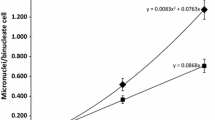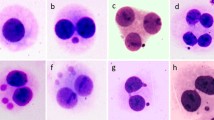Abstract
The lymphocyte cytokinesis-block micronucleus (CBMN) assay is a biodosemeter for the exposure to ionizing radiation. We examined the feasibility to implement a fully automated cell harvesting system for binucleate lymphocyte (BN) fixation. We compared fully automated versus manual BN fixation and evaluated its relevance on the accuracy of dose estimates using the CBMN. First, dose–response curves based on X-ray irradiated blood samples of ten healthy donors (0–4 Gy, dose rate 1.0 Gy/min) were established. BN was either prepared manually or fully automatically using the Hanabi cell harvester system PII. Slides were finally scored following an automatic or semi-automatic approach using the Metafer4 platform. The variance was calculated per dose and separately for each of the four fixation and scoring combinations. Thereafter, a serial of 16 blood samples of unknown exposure doses (0–3.9 Gy X-ray) was analyzed. Employing the four fixation and scoring combinations, we compared the number of dose estimates lying outside the ±0.5 Gy interval and the mean absolute difference (MAD) and examined sensitivity, specificity and accuracy of doses merged into binary dose categories of clinical significance. Irrespective of the fixation procedure, we observed at doses ≤1.0 Gy about 2–4 times higher median variances for the automated scoring procedure over the semi-automated approach (p ≤ 0.03). The lowest median variance was observed for automatic fixation + semi-automated scoring (135) which was even 2 times lower relative to manual fixation + semi-automated scoring (276, p = 0.04). These differences became negligible after doses >1.0 Gy. For the automatic fixation procedure, we also observed a tendency toward borderline significant higher numbers of dose estimates falling into the ±0.5 Gy interval (25 %, p = 0.08) and lower MAD values (50 %, p = 0.09), which was predominantly caused by the accuracy of dose assessment >1.0 Gy. Regarding the discrimination of binary dose categories of clinical significance, we observed a good agreement of both fixation procedures. The implementation of the automatic cell harvesting system considerably reduces the workload and results in dose estimates with a tendency of being slightly more accurate as they are after a manual fixation.



Similar content being viewed by others
References
Abend M, Rothkamm K, Romm H, Badie C, Balagurunathan Y, Barnard S, Bernard N, Boulay-Greene H, Brengues M, De Amicis A, De Sanctis S, Greither R, Herodin F, Jones A, Knie T, Kabacik S, Kulka U, Lista F, Martigne P, Missel A, Moquet J, Oestreicher U, Peinnequin A, Poyot T, Roessler U, Scherthan H, Terbrueggen B, Thierens H, Valente M, Vral A, Zenhausern F, Meineke V, Little MP, Beinke C (2013) NATO biodosimetry study: comparison of established and emerging biodosimetry assays. Radiat Res 180(2):111–119
Ainsbury EA, Al-Hafidh J, Bajinskis A, Barnard S, Barquinero JF, Beinke C, de Gelder V, Gregoire E, Jaworska A, Lindholm C, Lloyd D, Moquet J, Nylund R, Oestreicher U, Roch-Lefévre S, Rothkamm K, Romm H, Scherthan H, Sommer S, Thierens H, Vandevoorde C, Vral A, Wojcik A (2014) Inter- and intra-laboratory comparison of a multibiodosimetric approach to triage in a simulated, large scale radiation emergency. Int J Radiat Biol 90(2):193–202
Bolognesi C, Balia C, Roggieri P, Cardinale F, Bruzzi P, Sorcinelli F, Lista L, D’Amelio R, Righi E (2011) Micronucleus test for radiation biodosimetry in mass casualty events: evaluation of visual and automated scoring. Rad Meas 46:169–175
Fenech M (1993) The cytokinesis-block micronucleus technique and its application to genotoxicity studies in human populations. Environ Health Perspect 101(Suppl 3):101–107
Fenech M (2000) The in vitro micronucleus technique. Mutat Res 455:81–95
Fenech M, Crott JW (2002) Micronuclei, nucleoplasmic bridges and nuclear buds induced in folic acid deficient human lymphocytes-evidence for breakage-fusion-bridge cycles in the cytokinesis-block micronucleus assay. Mutat Res 25; 504(1–2):131–136
Fenech M, Morley AA (1986) Cytokinesis-block micronucleus method in human lymphocytes: effect of in vivo ageing and low-dose X-irradiation. Mutat Res 161:193–198
Fenech M, Holland N, Chang WP, Zeiger E, Bonassi S (1999) The HUMN Project - An international collaborative study on the use of the micronucleus technique for measuring DNA damage in humans. Mutat Res 428:271–283
Fenech M, Holland N, Zeiger E, Chang WP, Burgaz S, Thomas P, Bolognesi C, Knasmueller S, Kirsch-Volders M, Bonassi S (2011a) The HUMN and HUMNxL international collaboration projects on human micronucleus assays in lymphocytes and buccal cells—past, present and future. Mutagenesis 26(1):239–245
Fenech M, Kirsch-Volders M, Natarajan AT, Surralles J, Crott JW, Parry J, Norppa H, Eastmond DA, Tucker JD, Thomas P (2011b) Molecular mechanisms of micronucleus, nucleoplasmic bridge and nuclear bud formation in mammalian and human cells. Mutagenesis 26(1):125–132
Fenech M, Kirsch-Volders M, Rossnerova A, Sram R, Romm H, Bolognesi C, Ramakumar A, Soussaline F, Schunck C, Elhajouji A, Anwar W, Bonassi S (2013) HUMN project initiative and review of validation, quality control and prospects for further development of automated micronucleus assays using image cytometry systems. Int J Hyg Environ Health 216(5):541–552
Garty G, Chen Y, Turner HC, Zhang J, Lyulko OV, Bertucci A, Xu Y, Wang H, Simaan N, Randers-Pehrson G, Lawrence Yao Y, Brenner DJ (2011a) The RABiT: a rapid automated biodosimetry tool for radiological triage. II. Technological developments. Int J Radiat Biol 87(8):776–790
Garty G, Karam A, Brenner DJ (2011b) Infrastructure to support ultra high throughput biodosimetry screening after a radiological event. Int J Radiat Biol 87(8):754–765
International Atomic Energy Agency IAEA (2011) Vienna: Cytogenetic dosimetry: applications in preparedness for and response to radiation emergencies. EPR-Biodosimetry. http://www-pub.iaea.org/MTCD/publications/PDF/EPR-Biodosimetry%202011_web.pdf.2011
ISO 17099 (2014) Radiological protection—performance criteria for laboratories using the cytokinesis block micronucleus (CBMN) assay in peripheral blood lymphocytes for biological dosimetry. http://www.iso.org/iso/catalogue_detail.htm?csnumber=59141. Accessed 10 Nov 2014
Lloyd DC, Edwards AA, Moquet JE, Guerrero-Carbajal YC (2000) The role of cytogenetics in early triage of radiation casualties. Appl Radiat Isot 52:1107–1112
McNamee JP, Flegal FN, Boulay-Greene H, Marro L, Wilkins RC (2009) Validation of the cytokinesis-block micronucleus (CBMN) assay for use as a triage biological dosimetry tool. Radiat Prot Dosim 135(4):232–242
Multibiodose (2013) Guidance for using MULTIBIODOSE tools in emergencies for radiation emergency response organisations in Europe. http://www.multibiodose.eu/News/MBD_Guidance_web.pdf, Accessed 26 May 2014
Multibiodose project 2010–2013. Multi-disciplinary biodosimetric tools to manage high scale radiological casualties (MULTIBIODOSE)—capability project funded within the 7th EU Framework Program. http://www.multibiodose.eu/index.htm, Accessed 26 May 2014
RENEB project 2012–2015. Realizing the European network in biodosimetry (RENEB)—coordination action funded within the 7th EU framework program. http://www.reneb.eu/. Accessed 26 May 2014
Romm H, Barnard S, Boulay-Greene H, Herodin F, Martigne P, Peinnequin A, Poyot T, Valente M, De Sanctis S, De Amicis A, Franco M, Moquet J, Kulka U, Lista F, Oestreicher U, Rothkamm K, Thierens H, Vandersickel V, Vral A, Little M, Meineke V, Beinke C, Abend M (2013) Laboratory intercomparison of the cytokinesis-Block Micronucleus assay. Radiat Res 180(2):120–128
Shibai-Ogata A, Kakinuma C, Hioki T, Kasahara T (2011) Evaluation of high-throughput screening for in vitro micronucleus test using fluorescence-based cell imaging. Mutagenesis 26(6):709–719
Thierens H, Vral A, Vandervoorde C, Vandersickel V, de Gelder V, Romm H, Oestreicher U, Rothlamm K, Barnard S, Ainsbury EA, Sommer S, Beinke C, Wojcik A (2014) Is a semi-automated approach indicated in the application of the micronucleus assay for triage purposes? Rad Prot Dosimetry 159(1–4):87–94
Tucker JD, Vadapalli M, Joiner MC, Ceppi M, Fenech M, Bonassi S (2013) Estimating the lowest detectable dose of ionizing radiation by the cytokinesis-block micronucleus assay. Radiat Res 180(3):284–291
Vral A, Fenech M, Thierens H (2011) The micronucleus assay as a biological dosimeter of in vivo ionising radiation exposure. Mutagenesis 26(1):11–17
Willems P, August L, Slabbert J, Romm H, Oestreicher U, Thierens H, Vral A (2010) Automated micronucleus (MN) scoring for population triage in case of large scale radiation events. Int J Radiat Biol 86(1):2–11
Acknowledgments
An ethical approval was obtained from the University of Ulm ethics committee (No. 163/09) which allows analyzing in vitro induction of micronuclei in lymphocytes after venipuncture of volunteers with informed consent. We wish to thank all volunteers who participated in this study. Our particular thanks go to Susan Klause for the extensive micronucleus scoring necessary for this study.
Author information
Authors and Affiliations
Corresponding author
Rights and permissions
About this article
Cite this article
Beinke, C., Port, M. & Abend, M. Automatic versus manual lymphocyte fixation: impact on dose estimation using the cytokinesis-block micronucleus assay. Radiat Environ Biophys 54, 81–90 (2015). https://doi.org/10.1007/s00411-014-0575-0
Received:
Accepted:
Published:
Issue Date:
DOI: https://doi.org/10.1007/s00411-014-0575-0




